Building an online course can be a great way to earn money as a solopreneur. In fact, the median amount that people earn per course on Podia is $198 per month, and we’ve seen individual courses sell for over $100,000!
But while making an online course is a huge achievement on its own, long-term success comes when that course is part of a bigger business.
That’s why choosing the right online course platform isn’t just about where you host your lessons. It’s about finding a tool that helps you build everything else you need surrounding your course, like your website, landing pages, email marketing, affiliates, and other digital products.
In this article, we’ll cover:
-
Why it’s important to pick a platform that helps you create a course and a business
-
13 best online course platforms for creators, solopreneurs, and small business owners
Every online business is unique, and we want you to find the tool that works best for you.
And hey, since you’re reading this on Podia’s website, you’ll see plenty of Podia love — we built it with creators like you in mind, and we truly believe you’ll love it too.
But at the end of the day, what matters most is that you have the right tools to succeed, no matter which platform you go with. So keep reading to find the best fit for your business.
There are hundreds of course builders out there. Where do I start?
The truth is, there are lots of great platforms for building courses.
These days, it’s expected that course platforms will let you set up modules and lessons, easily add course videos and content, customize your branding, and securely process payments.
But not all of them will have the features you need to create a great business.
Sure, you may only want to build a course right now, but you’ll eventually need marketing tools to sell that course.
You’ll probably want a website or at least a sales page to promote what you’ve made. And it would be helpful to have email marketing, a blog, and features like coupons and upsells to connect with people and get them excited to buy.
Using separate platforms for all these things gets complicated and expensive fast.
That’s why we recommend picking an all-in-one tool that will let you build your dream course, but also everything else you need to build a business off the back of that course.
13 best online course platforms for creators and entrepreneurs
Here’s a quick look at the top course platforms and who they’re best for. Keep reading for the nitty gritty details.
-
Podia — Best all-in-one platform for solopreneurs who want to build a business. Podia includes your courses, downloads, webinars, coaching, website, blog, email marketing, and affiliates in one place.
-
Kajabi — All-in-one platform with advanced features for building your course and business, but also higher prices and product/customer limits.
-
Thinkific — All-in-one platform with courses, products, and communities, plus an app store so you can add-on extra tools if needed.
-
Teachable — All-in-one platform for selling courses, downloads, and coaching with product limits on all plans.
-
LearnWorlds — Course-focused platform for small business owners who want to build their own mobile app (for an additional fee).
-
LearnDash — Course plugin for building and selling courses using WordPress.
-
Systeme.io — All-in-one sales funnel tool where you can sell courses and list your products on an affiliate marketplace.
-
Mighty Networks — Fully-featured community platform with the option to sell courses on higher-tiered plans.
-
Teachery — Basic online course platform with simple pricing (and a one-time-payment option).
-
Stan Store — Best for selling over social media through your link in bio.
-
Payhip — Digital product platform that lets you sell physical products alongside your digital products.
-
Udemy — Learning marketplace where you don’t have to do your own course marketing, even if it means lower earnings.
-
Skillshare — Learning platform for offering video courses with a revenue share model.
#1 Podia
Podia is an all-in-one platform where you can sell online courses, build a website, run your blog, and offer digital downloads, coaching, and webinars. You can also do email marketing, manage your affiliate program, and message your customers from one dashboard.
All Podia plans come with unlimited courses and products so you can make whatever you want, and setting up your first course is a breeze.
Just select a new course product in your dashboard and click to add text, videos, audio files, quizzes, coaching sessions, and file downloads to your lessons and modules. You can also embed elements from 1900+ sources, including YouTube, Vimeo, SoundCloud, Spotify, Google Slides, TikTok, Instagram, GitHub, and Google Forms.
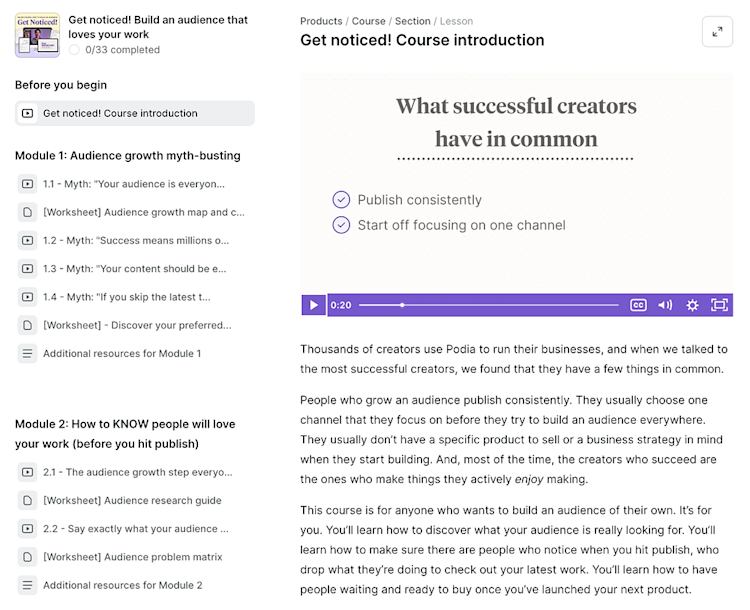
Courses in Podia can be self-paced or cohort style, and you can set future start dates and seat limits. You can make timed access limits, drip out course content over time, and include access to other products within your courses. You can also enable comments and discussion forums so students can collaborate.

For Bex Irvine, setting up courses in Podia couldn’t be easier. She says, “I just pop in my text and videos and publish.”
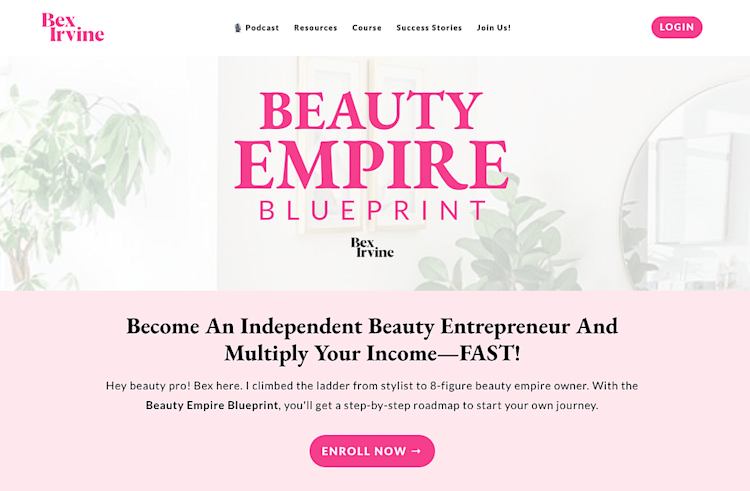
Once you’ve added your course material, use Podia’s beginner-friendly page builder to design a course website or sales page for your offer. Podia automatically generates a sales page for each product you create, and you can use this as is, or customize it however you like.
Now you’re all set to share your course with your audience and watch the sales roll in. And when you’re ready to expand with other products, blogging, affiliates, sales funnels, or email newsletters, Podia has all those features ready to go so you don’t have to learn any new tech.
According to professional bladesmith Ben Abbott, “I’ve always dreamed of creating online classes that help bladesmiths of all skill levels improve their craft. Podia has helped make that possible through their incredibly straightforward and powerful platform.”

How does it help me grow my business?
Podia offers all the functionality you need to build a business around your core course offer. We’ve seen thousands of creators build wildly successful course businesses, but it’s rarely just the course that leads to growth. They also have a great website, landing pages, email marketing, and other products to offer their customers.
All Podia plans include all email marketing features (like automations, newsletters, email templates, segmentation, tagging, and campaigns) for up to 100 subscribers. If you like, you can upgrade your Podia Email plan to add more subscribers as your list grows.
Podia also includes a free migration service when you sign up for any paid plan. This means our team will move your products and customers over from another platform for free so you can get started fast.
On top of that, you’ll have tons of support resources to keep the momentum going, including our top-tier customer support, access to the expert Podia Pros, and the Podia Community. As sketchnote artist Emily Mills puts it,
“On my old course platform, I had a lot of problems. The customer service was really slow and impersonal, and it was just a bad experience. When I switched to Podia, it was just a night and day difference. The customer service has been fast and personal, it’s easy to use, and it’s creator-focused. The platform isn’t getting in my way, and I’ve been able to make a lot more money with Podia.”
Bottom line: Podia lets you build, sell, and manage everything in one place.
What are Podia’s features?
-
Sell unlimited courses, coaching, and digital downloads on all plans
-
Unlimited customers
-
Intuitive website builder and blog with the ability to connect a custom domain
-
Payment integrations with Stripe and PayPal
-
Coupons, upsells, product bundles, payment plans
-
Waitlists and preselling
How much does Podia cost?
Podia has a 30-day free trial and two paid plans:
-
Mover Plan ($39/month or $33/month billed annually): Includes a website, online store, email marketing, and unlimited digital products, courses, webinars, and coaching. Mover also has your community, blog, custom domain, and friendly support. 5% transaction fees.
-
Shaker Plan ($89/month or $75/month billed annually): Offers all features in the Mover Plan plus affiliate marketing. No transaction fees.
Both plans include access to Podia’s email platform for up to 100 subscribers. Additional subscribers can be added for a fee.
Podia pros: Podia has a free trial where you can build your website, set up your blog, and start selling courses and products before opening your wallet. All plans include unlimited courses and digital products. Courses can be pre-launched, presold, waitlisted, or sold as bundles, and you can format your material into a cohort, drip, or self-paced program.
Podia cons: Podia is a turnkey solution, so if you prefer to build your course and website from scratch with the help of a developer, it won’t be the best fit.
#2 Kajabi
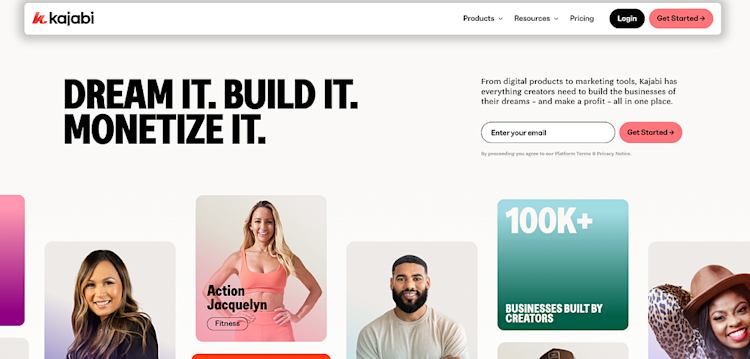
Kajabi is an all-in-one platform where you can sell courses, downloads, coaching, podcasts, memberships, and communities. You also get email marketing tools, sales funnels, and affiliate management.
One perk of Kajabi is that they include templates for self-study, drip, and membership courses. You can add as many modules and lessons as you like, including videos, assessments, audio files, text, and downloadable content.
Kajabi also has the option to set up a branded mobile app for your business for an extra fee each month.
How does it help me grow my business?
Kajabi is an all-in-one tool for entrepreneurs, so you can use it to build an entire business. Your courses, products, and website are all in one spot and everything is connected. That said, all plans have product limits and the pricing can get pretty expensive as you grow.
If you only have a limited number of products/courses and you have the budget for it, Kajabi can be a good fit if you want to go beyond an easy set up and build something completely custom.
What are Kajabi’s features?
-
Sell courses, downloads, coaching, memberships, podcasts, and newsletters
-
Upsells, coupons, subscriptions, and payment plans
-
Abandoned cart recovery
-
Course insights and analytics
-
Email broadcasts, campaigns, pipelines, automations, and sequences
-
Branded mobile app available as an add-on
How much does Kajabi cost?
-
Kickstarter Plan ($89/month or $71/month billed annually): 1 product, 1 community, 250 contacts, 7,500 marketing emails
-
Basic Plan ($149/month or $119/month billed annually): 3 products, 10,000 contacts, unlimited marketing emails
-
Growth Plan ($199/month or $159/month billed annually): 15 products, 25,000 contacts, unlimited marketing emails
-
Pro Plan ($399/month or $319/month billed annually): 100 products, 100,000 contacts, unlimited marketing emails
Kajabi pros: Kajabi has a pipeline tool that allows you to make advanced sales funnels. There are also website templates you can use to jumpstart your creativity. Kajabi doesn’t charge transaction fees on any of their paid plans.
Kajabi cons: Kajabi is one of the more expensive online course platforms for creators, and there’s no free plan. There are also strict limits to how many products you can create on all plans.
For instance, Kajabi’s lowest-price Kickstarter plan only includes one product, one community, and 250 contacts, which is very limited considering the $89/month price tag.
According to our 900+ creator survey, creators sell an average of 10.95 products. This means many would have to use Kajabi’s higher-priced Growth plan ($199/month or $159/month billed annually) or Pro plan ($399/month or $319/month billed annually).
When we ask customers why they switched to Podia from Kajabi, we hear things like “the price of Kajabi” and “Kajabi does not offer unlimited products.” Just something to keep in mind so you don’t have to move everything over as you grow.
#3 Thinkific
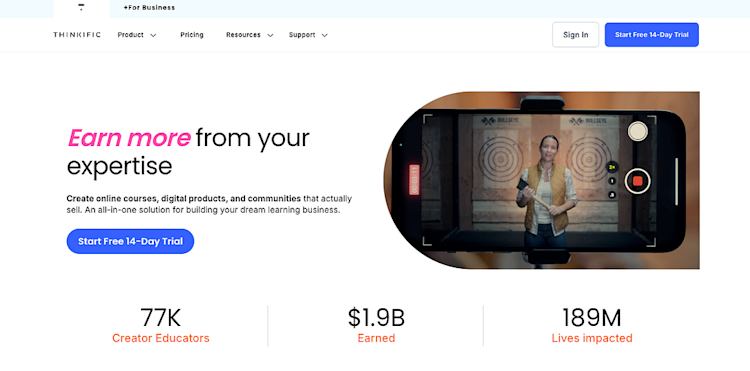
Thinkific is an all-in-one online course creation tool where customers can offer self-study courses, live lessons, video trainings, and cohort programs. You can build a website or storefront for your business, and there are templates to help you get started.
Within the course builder, Thinkific creators can add downloadable content, quizzes, surveys, and videos. Higher-tier plans let you enable prerequisite lessons and require students to finish modules in the correct order.
While it isn’t advertised on their website, it appears that Thinkific still has a free plan that includes one course, one community, and a limited website builder. There’s not a way to sign up for it through their site, but users on Reddit and YouTube say that you can still access Thinkific’s free plan by starting a 14-day free trial and downgrading to a free forever plan on the billing page.
How does it help me grow my business?
All Thinkific paid plans come with unlimited courses and students. You also get free access to their accelerator program, which is a yearlong program to help you set up your business.
As your business grows, you can use Thinkific to build a branded mobile app for an additional fee, or head to the Thinkific app store to add on additional tools. Thinkific also has AI features built into different parts of the product to help you move faster (which I suppose can be a pro or a con depending on how you use it).
What are Thinkific’s features?
-
Sell courses, digital products, and communities
-
Website builder, landing pages, and email automations
-
Abandoned cart, product gifting, order bumps
-
Quizzes and exams on higher plans
-
Course compliance tools, assignments, and course certificates
-
Access to Thinkific Payments and TCommerce
How much does Thinkific cost?
-
Free Plan ($0/month): Includes 1 course, 1 community with 2 spaces, and unlimited students. No transaction fees.
-
Basic Plan ($49/month or $36/month billed annually): Includes unlimited courses, 5 digital downloads, 5 coaching sessions, 1 community with 5 spaces, and unlimited students. No transaction fees.
-
Start Plan ($99/month or $74/month billed annually): Includes unlimited courses, 1 community with 10 spaces, unlimited digital downloads, unlimited coaching, and unlimited students. No transaction fees.
-
Grow Plan ($199/month or $149/month billed annually): Includes unlimited courses, 3 communities with 20 spaces each, and unlimited students. No transaction fees.
Thinkific pros: On the plus side, you can sell unlimited courses and host unlimited content on all paid plans. You can connect tools from the Thinkific app store for more functionality if you need additional features, and you can set up a branded mobile app for an additional fee.
Thinkific cons: Thinkific’s Basic plan has limits on the number of downloads, coaching sessions, and webinars you can make. There’s no blogging feature which means you’ll need a separate tool to publish blog articles.
Some desirable features like memberships, product bundles, and payment plans are only available on the Start plan ($99/month or $74/month billed annually) and above. And while Thinkific does let you make advanced quizzes and exams within your courses, this feature is only available on the Grow plan ($199/month or $149/month billed annually).
There’s also a big jump from the free plan to the Basic plan in terms of price. Podia business Twinimation Studios used to use Thinkific, but switched when their business grew.
They explain, “We used Thinkific for a while because of its free plan, but we were only able to host one course. Podia’s basic (Mover) plan is not only cheaper than numerous other alternative basic plans, but you get MORE than you would get on other hosts’ more expensive plans.”
#4 Teachable
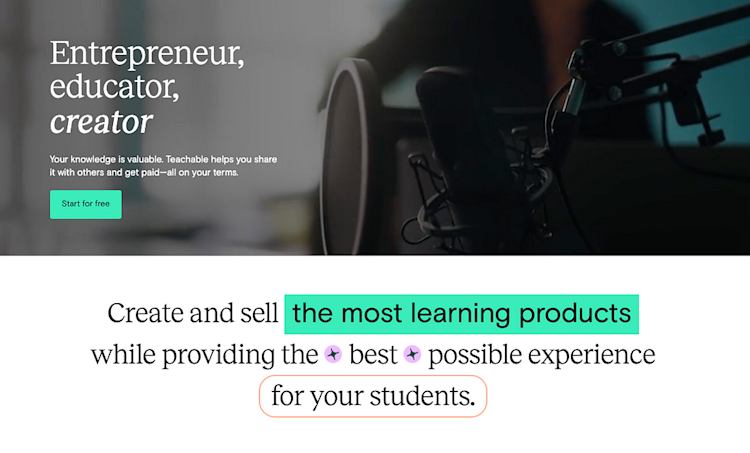
Teachable is another all-in-one platform where users can sell courses, downloads, community, and coaching packages to their audience. (Can you tell we love an all-in-one?)
Over 150K customers use the platform, and all paid plans come with course features like basic quizzes, course design templates, and drip content. Higher-tier plans also come with graded quizzes, course completion certificates, course compliance tools, and built-in affiliates.
Teachable does have a free plan, and the free version includes one course, one digital download, one coaching product, and ten students. The free plan has a transaction fee of $1 + 10% of each sale.
Paid plans come with a limited number of self-paced courses, cohort courses, digital downloads, and coaching products. While it is possible to set up landing pages and a basic website in Teachable, there’s no blogging feature.
Email marketing is fairly basic so you might need another tool to do more complex automations. Luckily, Teachable has integrations with several popular email platforms so you can make that happen.
How does it help me grow my business?
The big plus of Teachable and other all-in-ones is that you can make several different types of products in one platform. Teachable also has a strong built-in affiliates feature that handles payouts for you so you can grow through customer recommendations.
What are Teachable’s features?
-
Sell courses, downloads, coaching, memberships, and community
-
Course completion certificates, course design templates, quizzes, and lecture comments
-
Offer coupon codes, order bumps, and upsells
-
Build a custom storefront and sales pages for your courses
-
Affiliate center with automatic payouts
-
Basic email marketing features
How much does Teachable cost?
-
Free Plan ($0/month): Includes 1 course, 1 coaching product, 1 digital download, and supports up to 10 students. Transaction fee of $1 + 10% per sale.
-
Basic Plan ($59/month or $39/month billed annually): Includes 5 courses, 5 coaching products, 5 digital downloads, and unlimited students. Transaction fee of 5% per sale.
-
Pro Plan ($159/month or $119/month billed annually): Includes 50 courses, 50 coaching products, 50 digital downloads, and unlimited students. No transaction fees.
-
Pro+ Plan ($249/month or $199/month billed annually): Includes 200 courses, 200 coaching products, 200 digital downloads, and unlimited students. No transaction fees.
-
Enterprise Plan (Custom pricing): Includes unlimited courses, coaching products, and digital downloads, with support for unlimited students. No transaction fees.
Teachable pros: Teachable offers course compliance tools like lesson order enforcement to ensure students move through your material in the correct manner. There are also integrated affiliate tools and a student referral feature.
Teachable cons: While Teachable does have a free plan, there is a steep transaction fee ($1 + 10% on each sale) and limits on how many students you can have on that plan.
There’s no blogging tool, and the email marketing is still basic. That’s why Podia user Christy Price made the switch from Teachable + ConvertKit to Podia. She says, “I wanted a solution that was easier to use, had a better interface for students, and let me do digital sales and email marketing all in one.”
#5 LearnWorlds
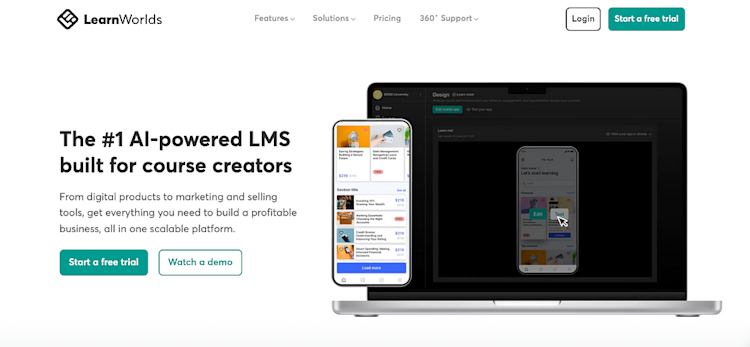
LearnWorlds focuses almost exclusively on courses, and you can set up interactive videos, build assessments and surveys, offer live sessions, and use built-in AI tools to help with content creation.
There are also some unique features to make your courses stand out, like video transcripts, video overlay buttons, and a way for students to highlight things inside your course. You can customize the flow of your courses with drip content, public and private course sections, and free and paid offers.
LearnWorlds can be used for website building, but there isn’t a blogging feature so you might need another tool for that. On the email side, some higher-tier plans have a mass email feature with a set number of email credits each month, but running automated campaigns will require a third-party email marketing integration.
There’s also a mobile app builder (for an additional fee) so you can set up a bespoke e-learning app for your audience.
How does it help me grow my business?
LearnWorlds is good for building a course business, and they have features to help you market your courses like a website, affiliates, and a pop-up builder. LearnWorlds also has a mobile app tool available for an extra fee of $149/month, so if you need a custom app for your business, this could be a good fit.
What are LearnWorlds’ features?
-
Sell courses, subscriptions, and bundles
-
Website and built-in pop-up tool
-
Integrated video editing tools and transcripts
-
Affiliate marketing
-
Mobile app (for an additional fee)
-
Unlimited SCORMs / HTML5
How much does LearnWorlds cost?
-
Starter Plan ($29/month billed annually or $24/month billed monthly): Unlimited paid courses, 3-page website, 1 admin, and a $5 fee per course sale.
-
Pro Trainer Plan ($99/month billed annually or $79/month billed monthly): Unlimited free and paid courses, customizable course player, assessments, certificates, 5 admins, and no transaction fees.
-
Learning Center Plan ($299/month billed annually or $249/month billed monthly): All Pro Trainer features plus interactive videos, auto-transcripts, advanced assessments, unlimited SCORMs/HTML5, and no transaction fees.
LearnWorlds pros: You can gamify your videos, add transcripts and subtitles, and see stats about the watch trends for your content. LearnWorlds users can also manage affiliates, create bundles and subscriptions, and build popups. It’s possible to set up a white-label iOS or Android app for an additional fee.
LearnWorlds cons: LearnWorlds is heavily geared towards course creators, which is great if you’re sure that’s the only type of product you need. But if you think you might also want to make other products, like downloads, coaching, webinars, communities, etc., you might feel limited as you grow.
LearnWorlds doesn’t include advanced email marketing so you may need an additional integration. They do have a mass emailing feature on the Pro Trainer plan and above, but you’re limited to a set number of credits. There aren’t built-in automations or campaigns.
Finally, there are steep fees on the LearnWorlds Starter plan. You can only offer paid courses (no free courses), and LearnWorlds charges a $5 fee per course sale. You can create a simple website, but you’re restricted to three pages.
You’ll need the Pro Trainer plan ($99/month billed annually or $79/month billed monthly) to get a full website and remove transaction fees.
#6 LearnDash

LearnDash is a WordPress learning management system (LMS) plugin with a customizable drag-and-drop course builder.
With LearnDash, you can create courses with prerequisites, drip content, memberships, and subscriptions. You can also send automated notifications to students, enable course discussion forums, and award certificates to successful students.
Courses can be subscription-based, memberships, or one-time purchases. Payments are handled through integrations with processors like Stripe, PayPal, and WooCommerce.
There are two different versions of LearnDash to choose from:
-
LearnDash plugin: This is a plugin you use with your existing WordPress setup, and you provide your own hosting.
-
LearnDash Cloud: This is a service where you pay each month and LearnDash hosts your WordPress website for you.
How does it help me grow my business?
If you already use and like WordPress, LearnDash lets you easily add courses to your existing business. If you don’t mind using plugins and integrations, this is an easy way to add course functionality to your WordPress site and earn more money.
What are LearnDash’s features?
-
WordPress LMS plugin or Cloud option
-
Drag and drop course builder
-
Enroll unlimited students and sell unlimited courses
-
Works with most WordPress themes
-
One-time purchases, subscriptions, memberships, course bundles, and bulk licenses
-
Student incentives, quizzes, certifications, and evaluations
How much does LearnDash cost?
-
LearnDash Plugin: ($199/year for 1 site, $399/year for 10 sites, $799/year for unlimited sites).
-
LearnDash Cloud: ($29/month or $25/month billed annually for Starter, $49/month or $41/month billed annually for Growth, $99/month or $83/month billed annually for Pro).
-
Add-ons: ProPanel ($49/year), Group Management ($199/year).
-
If not using Cloud: Costs of hosting your WordPress website
LearnDash pros: LearnDash offers student engagement tools like quizzes, leaderboards, gamification, and assignments. LearnDash doesn’t take any transaction fees, and you can use the plugin with most WordPress themes, making it highly customizable. There’s also the LearnDash Cloud option if you don’t want to worry about setting up hosting yourself.
LearnDash cons: LearnDash must be used with WordPress, and WordPress has a steep learning curve. You may need to work with a website developer to get your course looking exactly the way you want.
Plus, when you sell online courses on WordPress, you’re responsible for maintaining all the pieces. If something breaks, you’ll need to collaborate with different support teams, which can be tedious and inefficient. And on top of that, LearnDash only offers email and ticket support (no live chat), so it might take a while to get a response.
As one previous WordPress user put it, they switched to Podia because WordPress had “too many bugs and conflicts between plugins. It was too complicated and no one to speak to when you have a problem.”
Simply put, LearnDash is best suited for course builders who are already comfortable with WordPress.
#7 Systeme.io
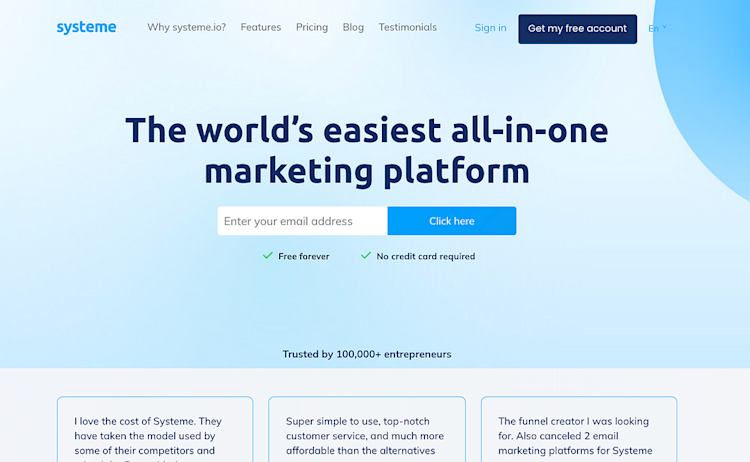
Systeme is an all-in-one marketing platform with courses, communities, and pre-recorded webinars. You can set up a website and blog, build sales funnels, and create email campaigns. Plus, Systeme has features for selling physical products.
Sales funnels are a core feature of Systeme, and you’ll use funnels to run most parts of your business. For example, to sell a course, you’ll create the course in the “Assets” area, then you’ll go to the “Funnels” area to sell it by adding an order form, thank you page, and any other funnel steps you want.
One of the most unique parts of Systeme is their built-in affiliate marketplace. When you make a course, you can choose to have it listed in the affiliate marketplace where anyone on Systeme can promote your course for a commission.
While there’s a lot Systeme can do, I found the platform somewhat challenging to use when I tested it for this blog post (even trying to be objective about it because this is an honest review). Setting up a course was easy, but I spent a long time trying to figure out how to sell the course (i.e., make a sales page and checkout page to collect payment).
I eventually figured out that I needed to go to the “Website” section and add a new sales funnel to make a checkout page and connect all the steps. But for me, it felt confusing to link price plans and checkout pages to a funnel instead of a specific product.
Perhaps this wouldn’t be an issue if I spent some more time in the tool, but, at first glance, it wasn’t the most intuitive to set up. That said, the sales funnel feature did have lots of steps and templates to choose from, so if you’re mainly interested in building standalone sales funnels this could be worth a look.
How does it help me grow my business?
Systeme is an all-in-one platform that’s focused on selling through sales funnels. There’s a free plan that lets you build one course, one community, and three sales funnels, which is nice for testing when you’re first starting out.
In addition to online courses and community, Systeme has tools for selling physical products and drop shipping, so you can expand your business into physical items if you like.
There’s also an affiliate network which is helpful for finding people to promote your products. You can earn money as an affiliate of other people’s courses or allow fellow Systeme users to promote your product to their audience in exchange for a commission.
What are Systeme.io’s features?
-
Blog and website builder
-
Sell courses, community, and pre-recorded webinars
-
Sales funnels, email marketing, and automations
-
Affiliate program management
-
Sell physical products
How much does Systeme cost?
-
Free Plan ($0/month): Up to 2,000 contacts, 3 sales funnels, 1 course, 1 community, and 1 automation rule.
-
Startup Plan ($27/month or $19/month billed annually): Up to 5,000 contacts, 10 sales funnels, 5 courses, 5 communities, and 10 automation rules.
-
Webinar Plan ($47/month or $33/month billed annually): Up to 10,000 contacts, 50 sales funnels, 20 courses, 20 communities, 100 automation rules, and evergreen webinars.
-
Unlimited Plan ($97/month or $69/month billed annually): Unlimited contacts, sales funnels, courses, communities, and automation rules.
Pros: Systeme has a free plan where you can set up one course, one community, and three sales funnels. You can also set up web pages and your blog. Systeme has a lot of funnel steps to choose from and each step has nice templates. This is one of the most affordable funnel-first tools on the market since there’s a free plan.
Cons: Webinars are only available on the Webinar plan ($47/month or $33/month billed annually), and they have to be pre-recorded, not live. There are product, funnel, and contact limits on all plans until you hit the Unlimited plan ($97/month or $69/month billed annually), and the setup wasn’t as intuitive as it could be.
#8 Mighty Networks
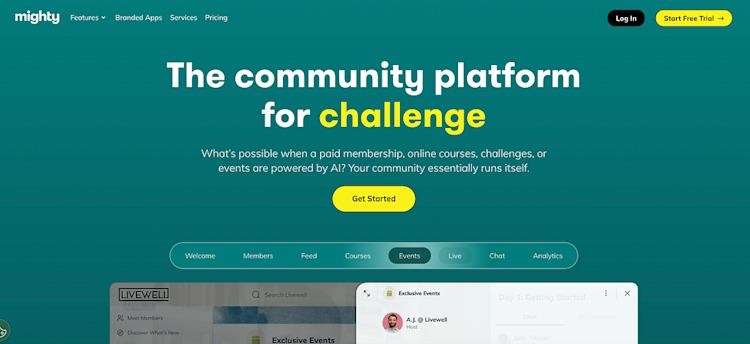
Mighty Networks is an online community platform where you can sell courses on the higher-tiered Courses plan.
All Mighty Networks plans come with unlimited members, unlimited spaces, and unlimited hosts/moderators in your community. You can host online events, personalize your community feeds, set up member profiles, gamify your community, chat with members, and run livestreams. For community access, you can charge a subscription or one-time fee.
If you plan to sell online courses, you’ll need to upgrade to the Course plan or above. At this tier, you can set up courses and course communities, and it’s possible to charge for course access. This tier also unlocks more storage and course-related automations and triggers.
While Mighty Networks does have your courses and community, it doesn’t have a website builder or blogging tool. They also don’t handle your email marketing or sales funnels, so you’ll need to connect additional tools for these features.
How does it help me grow my business?
Mighty Networks is a good option if you’re building a community-based business with courses added on. Community is where Mighty Networks shines and there’s a lot you can do with gamification and events within your spaces. Mighty Networks also has a member referral program so people in your community can recommend it to others who might be interested.
What are Mighty Networks’ features?
-
Communities with unlimited members, spaces, and moderators
-
Create unlimited courses on the Courses plan and up
-
Group and private chat messaging within your community
-
Livestreaming and live or virtual events
-
Member referral program
How much does Mighty Networks cost?
-
Community Plan ($49/month or $41/month billed annually): Unlimited members, events and polls, 250GB storage, and a 3% transaction fee.
-
Courses Plan ($119/month or $99/month billed annually): Unlimited courses, challenges, and resource libraries, 1TB storage, and a 2% transaction fee.
-
Business Plan ($219/month or $179/month billed annually): Integrations with other tools, enhanced livestreaming, white-labeling, 2TB storage, and a 2% transaction fee.
-
Path-to-Pro Plan ($360/month billed annually): Advanced automated workflows, additional white-labeling, 3TB storage, and a 1% transaction fee.
Mighty Networks pros: With Mighty Networks, you can create courses with a strong community element. Mighty Networks supports video courses, drip courses, and livestreaming, and you can add unlimited instructors or moderators.
Mighty Networks cons: Mighty Networks is, first and foremost, a community platform. There’s no built-in way to sell services like coaching or digital downloads. There’s also no website builder, blog feature, or email marketing, so you’ll need to connect other tools as your business grows.
Finally, there are storage limitations and streaming hour limits on all plans and transaction fees on all tiers.
#9 Teachery
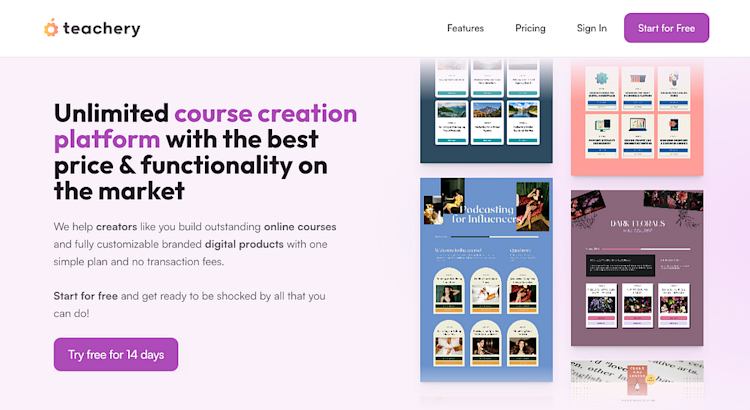
Teachery is simple but effective software made for course creators, by course creators. It doesn’t have a ton of bells and whistles, but it’s a straightforward option if you want to launch an online course.
Teachery features a course builder with customizable fonts, colors, and styles. Within your lessons and modules, you can embed video, audio, and slide presentations. To promote your course, you can create unlimited payment pages, sales pages, and email capture forms, as well as upsells, promo codes, affiliates, and course gifting.
One thing to consider is that Teachery is only set up for selling courses and course bundles. There isn’t a feature for offering downloads, coaching, communities, or webinars, and there isn’t a full website builder or blogging tool. Teachery also doesn’t have built-in email marketing, but they do integrate with email services like Kit and Mailchimp.
How does it help me grow my business?
Teachery has simple pricing and unlimited courses, students, and landing pages on all plans. The only difference is whether you pay monthly, annually, or lifetime. This is a good option if you already have a tool for your email and website, as these business-building features aren’t included.
What are Teachery’s features?
-
Unlimited courses, lessons, and students
-
Sell memberships and bundle products
-
Create sales pages and landing pages
-
Integrations with Mailchimp, ConvertKit, and Zapier
-
Affiliate program
-
Free, one-time, recurring payments
How much does Teachery cost?
All features are included on all plans, and the only difference is the payment interval.
-
Monthly Plan ($49/month): Includes unlimited courses, unlimited students, unlimited landing pages, custom domain, and customer analytics.
-
Annual Plan ($470/year): All features of the monthly plan at a discounted rate.
-
Lifetime Plan ($550 one-time fee): All the features for a one-time price
Teachery pros: Teachery lets you make as many courses as you want and customize them using the style editor. There are marketing tools like coupons, upsells, and affiliates, and there are no transaction fees on any plans.
Teachery cons: Teachery is not optimized for selling digital downloads or services. There’s no community feature, and they don’t provide video or audio hosting, so you’ll need to embed videos from third-party providers like YouTube and Vimeo. They also don’t have a website builder, blogging, or email marketing, so you’ll need integrations to add these features to your course business.
#10 Stan Store

Stan Store is a link in bio tool that also has features for selling courses and other products. You can use the platform to set up online courses, webinars, digital products, coaching, and memberships, and everything is available to buy right from your link in bio.
There are 11 different templates to choose from for your Stan Store page, and each one can be customized with your preferred font (11 fonts to choose from) and two brand colors. You can also set up mobile landing pages for each of your products using Stan Store’s pre-defined templates.
While you can technically use the platform to make as many courses as you like, Stan Store recommends listing 3–5 offers on your page so that mobile viewers don’t have to scroll too long to see all your stuff.
You can also add elements to your page like an email sign-up form, bio text, and links to your other social channels, but overall, the design elements are pre-set by the template you choose. If you like the templates provided and don’t need to make a ton of customizations, this might not be a problem though.
Stan Store also has a built-in affiliate feature and email marketing for your business. The email is available on the Pro plan, and it includes basic broadcast emails and automated emails called Flows.
How does it help me grow my business?
Stan Store is a good option if you want to grow your business over social media. Everything from your sales pages to courses are formatted for mobile first, so all you need to do is add your products, link them to your Stan Store homepage, and you’re ready to sell through social.
You can create lots of different product types, promote your products through affiliates, and upgrade for basic email marketing to stay in touch with people.
Something to be aware of though is that you may still need a website for your business if you want to grow beyond social media, which is something we recommend doing for more stability and control over your audience.
What are Stan Store’s features?
-
Link in bio storefront for mobile
-
Sell courses and digital products
-
Affiliate marketing feature
-
Email list sign-up forms and email marketing
-
Mobile-first landing pages
How much does Stan Store cost?
-
Creator Plan ($29/month or $25/month billed annually): Includes a mobile-optimized store, calendar bookings, product analytics, unlimited courses, subscriptions, lead magnets, and community features.
-
Creator PRO Plan ($99/month or $79/month billed annually): Adds advanced pricing, payment plans (Afterpay, Klarna), order bumps, upsells, unlimited funnels, affiliate links, email marketing, and analytics tracking.
Pros: Stan Store makes it easy to set up a link in bio fast with premade templates. You can sell courses and products from your bio link, set up affiliates, and collect email addresses through subscription forms. There are no transaction fees on either Stan Store plan.
Cons: The main limitation of Stan Store is that it’s not a full website for your business — it’s a nice link in bio tool with your products attached, but it likely can’t replace a full website with a blog and customizable landing pages.
This is great if you’re exclusively reaching your audience through social media, but if you want to contact people other ways down the line, you’ll need other tools. Plus, as your business grows and you offer more products, trying to condense everything into a list of buttons in your bio might start to feel limiting.
The other thing that could be a pro or a con is that there are just a few fixed templates with limited customizations. You won’t be able to change the look and layout of your homepage, products, or landing pages very much, but if you like the templates that come out of the box, then you’ll be good to go.
#11 Payhip
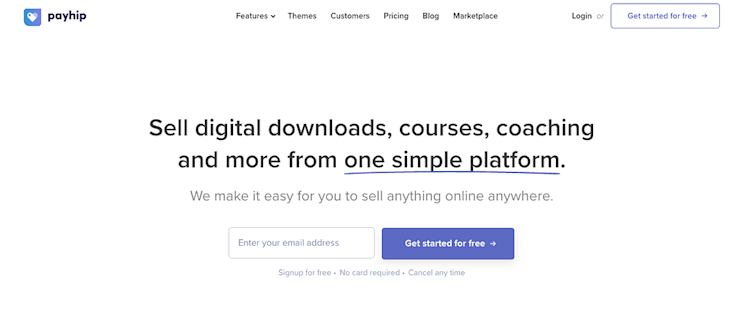
Payhip is an all-in-one option for selling digital downloads, courses, coaching, and physical products. To market your products, Payhip has coupons, affiliates, upsells, and referrals.
When I tested the course builder, it was easy to add my content and customize my sales page, checkout page, and thank you page. I could add unlimited lessons and modules, but each lesson could only fall under one category (like video, text, quiz, download, embed, etc.). I was also able to add course certificates and set up drip content.
There’s also an online store feature with blogging so you can grow your reach and get discovered by new course customers. It’s fairly easy to set up, but the available templates and sections definitely make your page look more like a storefront than a traditional website, so that’s something to consider.
Payhip also offers a basic email update feature that lets you send a blast to your customers. For more email marketing functionality, like running automations and building sales funnels, you’ll need to use a third-party email tool.
How does it help me grow my business?
Payhip is a good choice for selling physical products along with digital products since it has that functionality built in. It’s a good choice if you already have a website and email provider you like, but you just need a tool for listing and delivering products to your audience.
Also, there’s a marketplace feature where you can list your products so they can be discovered by other Payhip users.
What are Payhip’s features?
-
Sell downloads, courses, and coaching
-
Sell physical products
-
Coupons, affiliates, upsells, referrals
-
Store builder with blogging
-
Zapier and email marketing integrations
-
Payhip marketplace to share your products
How much does Payhip cost?
-
Free Plan ($0/month): Access to all features, unlimited products, unlimited revenue. 5% transaction fee.
-
Plus Plan ($29/month): Access to all features, unlimited products, unlimited revenue. 2% transaction fee.
-
Pro Plan ($99/month): Access to all features, unlimited products, unlimited revenue. No transaction fees.
Pros: Payhip comes with unlimited products and sales on all plans, including the free plan. You can sell tons of different products along with your courses, including physical products. You can build a simple storefront and a blog and collect email signups directly on your store.
Cons: You’ll need to use an email integration to do any advanced email marketing or automations with Payhip. While email blasts to customers are supported, you must connect (and potentially pay for) an extra tool if you want to run campaigns and automations or send designed newsletters to your audience.
#12 Udemy
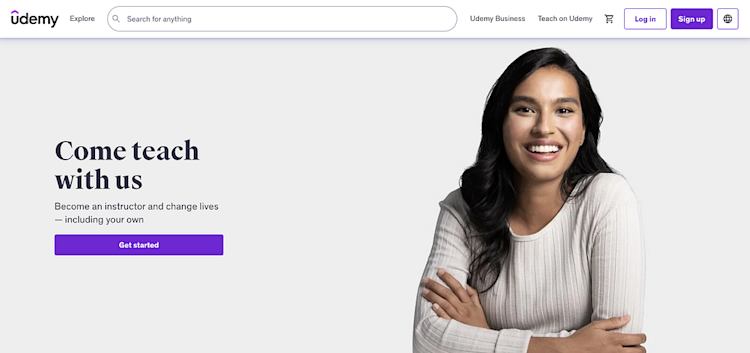
Udemy is an online course marketplace where creators can sell video courses to a wide audience.
It’s free to join as an instructor, upload your course videos, and set your price, but your product must meet Udemy’s quality requirements and fall under an approved topic. According to Udemy’s support documentation, courses should have at least 30 minutes of video content and at least five modules or lectures.
While some creators like selling on course marketplaces like Udemy for greater audience reach, Udemy has a lot of limits on what you can actually make. Your courses must follow their guidelines, and you can’t customize your course listing or create landing pages. You don’t have tools to build a website or storefront, nor can you make any other types of products.
Digital art course creator Carles Marsal switched away from Udemy “to keep everything in one place and have control over how my courses and products are shown and sold. I really wanted to look different, with a more personal approach to my audience.”
Udemy also has an aggressive revenue-sharing plan which can mean lower earnings for instructors. For instance, John D Saunders earned $1,100 from his course on Udemy, but when he moved that same course over to Podia, it earned him over $200,000 in sales — $10,000 of that was from launch day alone!
But if having access to Udemy’s audience and marketplace is a priority, this can be a low-lift way to set up and launch your video course.
How does it help me grow my business?
With Udemy, you can list your course as part of the Udemy Deals program where Udemy will discount it and promote it to their existing customer base. This is great for getting more eyes on your work, but you typically won’t earn as much as if you sold your courses yourself on a platform that you control.
What are Udemy’s Features:
-
Free to upload your courses as an instructor
-
User-friendly course builder and uploader
-
Learners can leave course reviews
-
Built-in marketing tools
-
Instructors can be included in site-wide deals to boost enrollment
How much does Udemy cost?
It’s free to join Udemy as a creator, but you’ll be part of Udemy’s revenue-sharing plan.
Revenue sharing plan:
-
The instructor keeps 97% when the student uses the instructor’s referral code
-
The instructor keeps 37% if no referral code is used
Udemy pros: If you want, you can have Udemy promote your courses for you so your marketing can be more hands-off. Udemy is also an established site with name recognition and a large existing audience, making it easier for students to discover you.
Udemy cons: On Udemy, you have less control over your content, branding, and income. You don’t own your audience, and you can’t migrate your student list off of the platform in the future. Also, you can’t run cohort courses, live courses, or membership courses.
There’s no way to gather student email addresses, and you’re limited to Udemy’s product listing templates and course requirements. If you want to build your own website or sell other types of products in the future, you’d need to use another platform.
#13 Skillshare

Skillshare is an online learning platform where instructors can upload video courses and make money through royalties. You don’t set a price for your courses and won’t have to do as much marketing, but you may earn less than if you sell your program independently.
Here’s how it works: Skillshare students pay a monthly fee for unlimited access to all courses on the platform, and teachers earn money based on how many minutes students watch their videos. Teachers can also earn by referring students to Skillshare.
Skillshare only accepts classes taught in English, French, German, Portuguese, or Spanish, and there are limits on what types of topics you can cover. Skillshare mainly looks for topics related to creativity, productivity, marketing, and personal development, and courses are usually 30–40 minutes long with a class project or activity.
There’s no cost to upload your class to Skillshare, but you’ll need to be approved to teach and you won’t start earning until you have some watch time on your videos.
How does it help me grow my business?
Skillshare can be a source of royalty revenue for creators, but it doesn’t help you build a business beyond that monthly income. You can’t build an email list or sell other products to your students, so you’ll need to use other tools to stay in touch with your audience and expand your offers.
That said, there are some successful Skillshare creators who send people to their Skillshare courses using their affiliate code which adds another stream of revenue.
What are Skillshare’s features?
-
Earn money through royalties based on watch time
-
Earn through the Skillshare affiliate program
-
Creators can be discovered by students already using the platform
-
Create video courses about topics like productivity, creativity, marketing, design, and personal development
How much does Skillshare cost?
It’s free to join and upload courses, but you get paid based on a revenue share model. Skillshare allocates about 20% of the total platform subscription revenue to a teacher payment pool. You earn a portion of this pool based on the total paid minutes that students watched your classes relative to the platform’s overall paid minutes.
Skillshare pros: Because Skillshare is an online learning library, there’s less marketing required on your end. Skillshare already has a built-in audience, which may mean more eyes on your classes without a ton of lift from you. It’s also free for creators to get started.
Skillshare cons: When you offer your courses on Skillshare, you don’t own your audience. You can’t build an email list of customers or leads, which makes it difficult to build a following and expand your revenue.
All lessons must meet Skillshare’s guidelines, which means you have less creative control over your work. There isn’t a community feature, and you can’t sell digital downloads, live cohort courses, memberships, or other formats beyond video lectures.
All in all, it can be a fine way to add supplemental income to your business, but it probably won’t be enough to be your whole business. For that, you’re better off with an all-in-one option that gives you your website, courses, downloads, email list, and everything else you need to grow.
Choosing the best online course platform for your creative business
Creating online courses can be a great way to expand your business and spread your knowledge, and there are lots of solid course platforms that can make your entrepreneurial dreams a reality.
But if you’re looking for an easy-to-use, all-in-one option that was specifically built for solo entrepreneurs, we’d love it if you gave Podia a try.
Create beautiful courses, sell digital downloads, offer webinars, start coaching, build a community, set up a website, start a blog, send email newsletters, run sales funnels, and keep an eye on everything all from one central hub.
You can test out all features free for 30 days, and as you grow, you’ll have everything you need for each stage of your business under one roof.
Your skills and experiences are valuable. By creating an online course, you’ll be well on your way to sharing your passion with others. Happy teaching!



